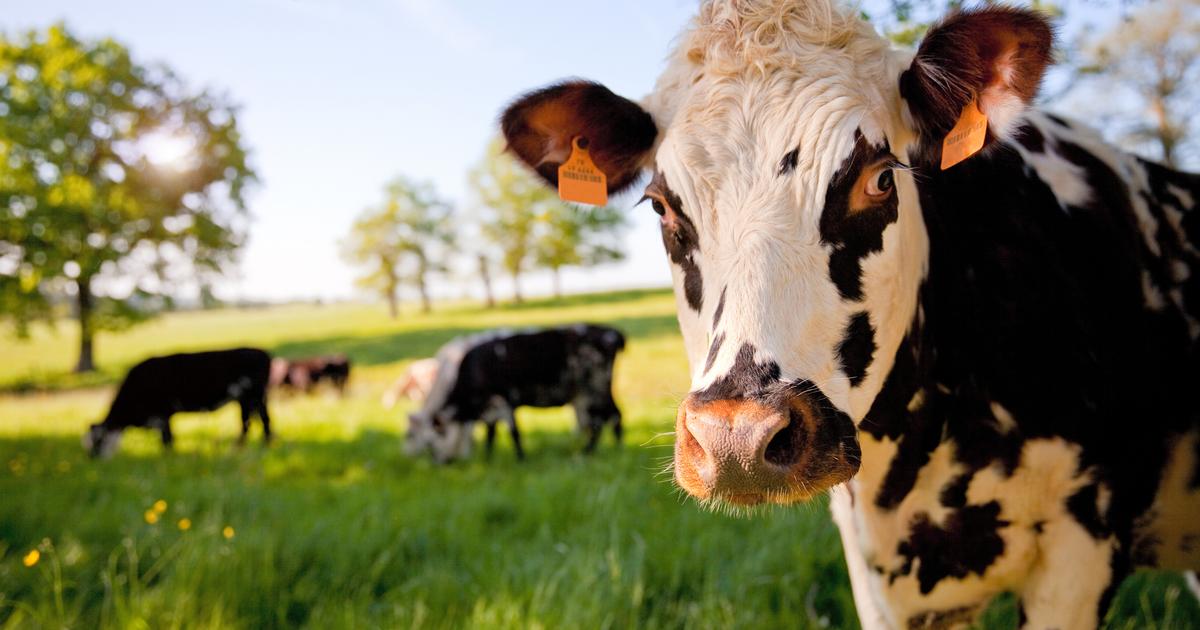The recommendation provoked the ire of French breeders. "Compliance with the France's commitments to reduce methane emissions necessarily calls for a significant reduction in the cattle herd," the Court of Auditors said in a report published on Tuesday, devoted to public support for cattle farmers. It didn't take long for the president of the FNSEA agricultural union, Arnaud Rousseau, to cry out for the "wound". "We are particularly annoyed by the trial that is made to French breeding. Reading that your activity must cease or largely decrease, it is very complicated for breeders, "he said Tuesday.
Farmers, however, know it: cattle production is one of the first emitters of methane (CH4), this gas with a much more warming effect than carbon dioxide. The fermentation produced by the digestion of cows creates methane that they expel through "burping" and flatulence. However, this phenomenon, natural and seemingly harmless, dangerously raises the planet's thermometer, since according to the IPCC, methane would be responsible for two-thirds of existing global warming. In France, agriculture is on the front line: according to the International Energy Agency, 67% of methane emissions are attributable to the sector, 87% of which is attributable to cattle farming alone.
But, according to the recent statements of the boss of the FNSEA, the production of gas by cattle is not inevitable. "Innovation can reduce emissions," he said. It is true that the issue has been a major concern for scientific and industrial purposes in recent decades. "There is a whole range of solutions," corroborates Jean-Baptiste Dollé, head of the environment department at the Institut de l'Élevage (Idele). While some are smiling, such as the methane mask for cattle tested by Cargill, others are already proving their worth, such as "herd management". This streamlined approach involves decreasing the age of first calving, improving health and reducing the turnover rate of animals to reduce the unproductive period. And thus avoid methane emissions "for nothing". "With herding management alone, we reduce total greenhouse gas emissions from livestock by 5 to 10%," explains Jean-Baptiste Dollé. By acting, at the same time, on the content of the rations - introduction of lipids, flax or nitrate, the methane released by the animals decreases by 20%.
Genomic selection
These methods are already within the reach of breeders. For the future, scientific research offers other perspectives. Among them, genetics, the object of many fantasies. Didn't Bill Gates invest 32 billion euros a few years ago in a genetically modified "perfect cow"? Without aiming for perfection, international researchers hope to reduce enteric methane emissions from cows through a global strategy of phenotyping and genomic selection. "This is not science fiction," insists Jean-Baptiste Dollé, even if the representative admits "it will take a few years" before scientific prowess materializes on farms.
More accessible perhaps, the development of food additives is on the rise. They offer the greatest potential for reducing CH4 emissions: 30% less. Authorized on the European market since last year, the 3NOP molecule blocks the action of an enzyme involved in the production of methane in the rumen. For the time being, any risk to animal and human health has been ruled out. "Their use in France is a matter of years, if not months," says Jean-Baptiste Dollé. In New Zealand, scientists are working on ultra-effective additives based on red algae. Specializing in these marine additives 2.0, the Australian company Rumin8 counts among its supporters Bill Gates, Jeff Bezos or Jack-Ma, the former boss of Alibaba.
Additional costs for farmers
Contrary to what the Court of Auditors' report suggests, the France is not lagging behind in this fight against methane. On the contrary. "We have launched our first decapration programs, whose method, recognized in 2018 by the government, is in the European Carbon Farming," says Jean-Baptiste Dollé. The Institute of Livestock claims 21,000 farms engaged in a diagnosis of their farm. Three quarters of them would have put in place an action plan. "We have solutions, but we must involve producers," says the representative of Idele. This has not always been an easy task. "In 2012, acceptability was very low. But when farmers started to suffer the effects of climate change themselves, the reception was stronger."
One obstacle remains: cost. Count 5 to 10 euros per ton of CO2 for technical support, between 10 and 100 euros for the solutions themselves. An article published in the daily La Croix puts the price of additives offered to farmers at five euros per cow per day. At this price, few breeders can afford to take the plunge. "Indeed, it is an additional cost for the exploiters," concedes Jean-Baptiste Dollé. However, farmers can apply for financial support from the CAP. The EU also gives them the opportunity to sell their tonnes of avoided methane back into carbon credits.
Not to mention the support of agro-industrialists. Sodiaal, McDonald's, Nestlé... Anxious to improve the carbon impact of their processed products, agribusiness giants happily finance diagnostics on farm emissions. In January, French giant Danone announced with great fanfare its desire to reduce methane emissions from its fresh milk chain by 30% by 2030.
But will this all-out mobilization be enough to overcome bovine flatulence? The Court of Auditors is far from convinced of this. "It is difficult to see how methane emissions could fall by 30% without affecting the cattle herd," says the report, which considers "limited" the efforts of the sector. The ideal, according to the institution, would be fewer animals on farms and less meat on the plate. "This reduction can be easily reconciled with the nutrition needs of the French," it reads. The engineer of the Idele regrets, him, that are ignored many promising innovations. "The solutions exist and will be applicable within five years. Implemented jointly, they will make it possible to meet our emission reduction targets," he said. It is up to the farmers to make the Sages lie.

